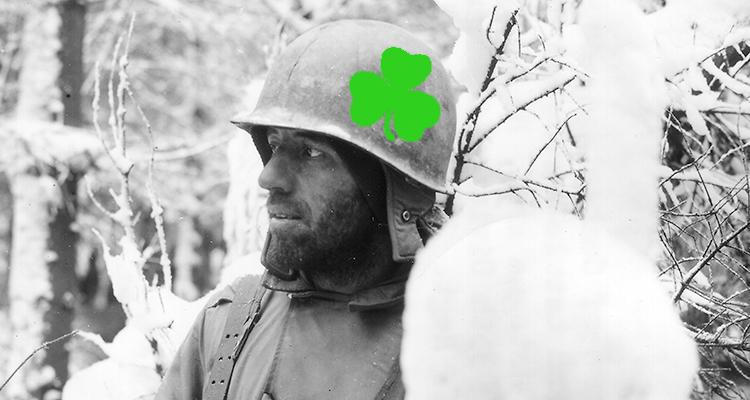I’ve been thinking a lot lately about the endgame of the war in the European Theater, early 1945. For the Germans, things had fallen apart. The Soviets were slashing deeply into East Prussia and crossing the Oder. The western allies first managed to ward off the German offensive into the Ardennes (Operation Wacht am Rhein, the so-called “Battle of the Bulge”), then launched a drive of their own over the German border into the Rhineland, one of the Reich’s crucial centers of population and industry. It seemed to be all over, and indeed it would be all over in a few months.
Hitler’s Germany was in the throes of collapse, in other words, and the Grand Alliance was ascendant. Heavily armed men on one side, with material abundance on land and in the air, facing flotsam and jetsam on the other, Volksgrenadier and Volkssturm divisions, old men and young boys often armed with nothing more than a single Panzerfaust or Panzerschreck and sent out to face the behemoths pressing into Germany from both sides. Many of them did their duty and beyond—getting blasted into the hereafter in their first encounter with the better armed forces of their adversaries. But in the end, it hardly seemed to matter. Numbers, time, and technology were all on the side of the Allies.
When we cast the narrative that way, it has a way of seeming inevitable. But the more I study the final stages of this vast campaign, the more that a single episode stands out to me. One that doesn’t seem foreordained. One that wasn’t reliant upon Allied superiority in firepower or numbers. One that had little to do with hordes of M4 Sherman tanks, P-51 fighters, or P-47 “jabos.” One, indeed, that could have gone either way, with a little tweak here or there.
One that we can only describe as a stroke of luck.
As 1945 dawned, it was clear that the end of the war was in sight. The Wehrmacht was doomed, and while it might be able to delay the eventual Allied victory, it had no more power to prevent it. Even so, Eisenhower and his armies faced a serious operational problem in the West: the Rhine. It is a major river, one that you don’t cross on the fly. It requires a carefully prepared operation, involving engineers, bridging trains, and a great deal of preparatory bombardment, and even weak forces should have been able to defend it adequately.
Certainly that’s the way that Eisenhower viewed the situation in early 1945. He was an experienced commander by now, one who had learned to react to his superiors’ admonitions to “hurry up” with a grain of salt. If there was one thing that Ike had learned by 1945, it was that operations tended to take their own time, no matter what President Roosevelt or General Marshall or the American press might think, and that it was almost always a slower time frame then Washington envisioned.
But then, on March 7, 1945, Eisenhower’s timetable changed. As U.S. 1st Army under the command of General Courtney Hodges approached the Rhine, his recon patrols began to report an unusual situation: uneven German resistance across the front, strong in certain locales, but altogether absent in others. Some forward units met strong German fire, an altogether familiar situation for Hodges since Normandy, but others seemed to be advancing into air. Most fortunate of all was the 9th U.S. Armored Division under Major General John W. Leonard. Tasked with an advance on the Rhine crossing at Remagen, Leonard’s boys managed to get to the river without incident. Seizing an opportunity, elements of the division (the 27th Armored Infantry Battalion, for the record), then forced passage of the Ludendorff Bridge over the Rhine. The men of the 27th knew they were taking a chance, crossing a big bridge over a major river with the expectation that the German defenders might blow it at any moment. I wasn’t privileged to talk to the brave Americans who crossed the bridge that day in March 1945, but I’m sure it must have been a nail-biting few minutes.
The Germans didn’t blow the bridge, however, a result of command confusion and fog of war more than anything else, and soon, almost miraculously, the American army was over the Rhine.
Yep… it seemed like a miracle. Even in the modern age of automatic weapons and firepower and logistics, miracles still happen. Hodges was not an excitable guy, but he seemed stunned. “Brad,” he shouted over the phone to his commanding officer, “we’ve got a bridge!” General Omar Bradley, commander of the U.S. 12 Army Group, was also a pretty phlegmatic personality—not given to excesses of enthusiasm or depression. Indeed, that was one of the reasons why Eisenhower had tapped him for army group command in the first place. But even he had to be impressed. “Hot dog, Courtney!,” he shouted back. “This will bust him wide open!”
“Hot dog”! Bradley’s joyful shout over that crackling radio link remains one of the great quotes of the war. We live in a more profane era today–and frankly, so did a lot of Bradley’s officers and men—and so we can imagine a number of more “colorful” responses to Hodges’s report. But even so, Bradley’s meaning is loud and clear. He had just gotten some good news, something that he couldn’t have expected in his wildest dreams. A stroke of good fortune.
Which leads to a question that we should ponder: how much of World War II (or any war) was due to good luck?
More next time.





